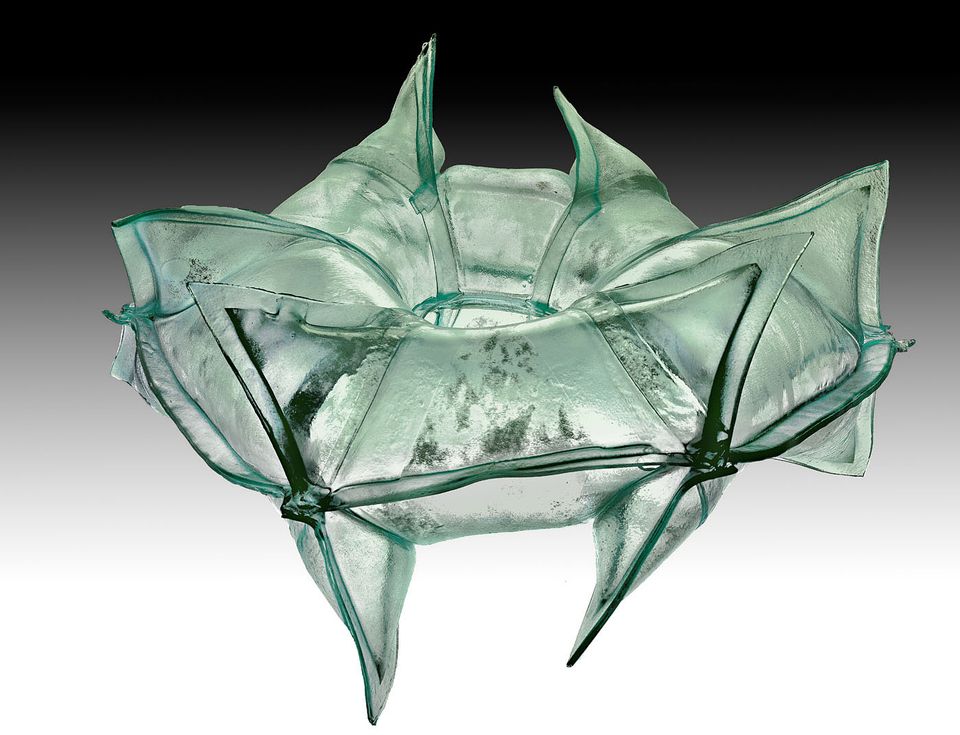

"I'll be talking about the entire history of studio glass, all 3500 years of it, in about twelve minutes. That's 300 years per minute but I'm going to skip some centuries entirely," William Warmus, independent curator and studio glass expert said at the beginning of the recent program at the Renwick Gallery titled "Art Glass @50," that also featured the artists Toots Zynsky and Matthew Szösz.
Warmus began with an image of a volcano, citing that as the first furnace, before moving to a picture of the Golden Mask of Tutankhamun from about 1500 BC—a bit of Egyptian bling—what he called, "the first important work of glass in mixed media." According to Warmus, "In a sense, glass began as a studio craft, and it began in relation to a royal court. Today we have collectors to replace pharaohs...I hope." Fast forward to the invention of glass blowing, then the Middle Ages, when things really started to get interesting, and "glass came into its own as a very high form of art." With an image of Saint Chappelle in Paris on the screen, Warmus described how glass became "a spiritual medium." Onward to the invention of the lightbulb, and improvements to lighting and design thanks to the likes of Louis Comfort Tiffany and Emile Galle. Picasso experimented with glass, but fast forward to the second half of the twentieth century and we meet Dale Chihuly. "He's definitely a pop artist, definitely a dramatist, but for me he's been essentially just a color field artist." Museums began to take notice, and one exhibition organized by Corning and seen at the Renwick, New Glass (1980) made a world of difference. Today, more than 165 museums around the country are featuring exhibitions of studio glass. And to end, kind of where he began, Warmus showed us an image of a Kiki Smith bronze inset with glass eyes, a technique that was first used by the ancient Egyptians in their funerary masks.
Toots Zynsky, a glass artist for more than 40 years, had a much simpler goal: to cover 40 years in ten minutes. She told us about her childhood experiences going to church and being fascinated by the stained glass windows. At the Rhode Island School of Design, in 1969, about to drop out, she found art glass...and Dale Chihuly who would become her teacher. She described working with glass which is both a fluid substance and a substance that also becomes frozen in time. "It's an endlessly fascinating material," Zynsky said. She spent sixteen years living in Europe and took a trip to Africa, that would change her personal and world view. She told us how at one point she took time off to deal with personal and family matters and returned to the studio not knowing what was next. Perhaps after thirty-five years, it was time for something new. One day her son walked into her studio and told her to create something in red, her favorite color (and also the color of funerals in Africa) and something started to click.
Matthew Szösz, whose work Untitled (Inflatable) no. 43 is included in the current exhibition, 40 Under 40: Craft Futures, calls himself "an accidental glass artist." He began his presentation with a video that showed him in the hot shop with all the good and bad things that happen inside. "Most of the things that I do are experimental in nature. I spend a lot of my time looking at failures both of mine and of other people and finding interesting things that the glass does and exploit that and maybe turn it into something that's a bit more captivating."
Together, Warmus, Zynsky, and Szösz showed us not only the foundation of art glass, but their talk also acted as a spring board for showing us what's new, what's next, and what's possible in a medium that is both ancient and contemporary, opaque and clear, fragile and strong.

















